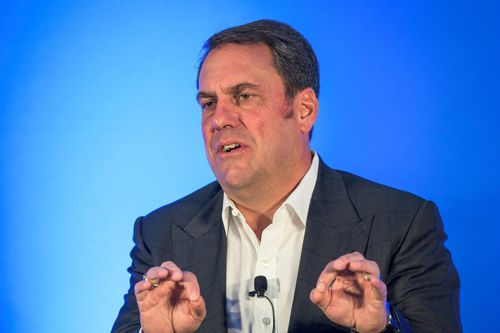
General Motors Executive Vice President of Global Product Development, Global Purchasing and Supply Chain Mark Reuss.
(Photo: Steve Fecht for General Motors)
Oct. 2, 2017, is historic inside General Motors human resources.
That’s the day when product development boss Mark Reuss told a group of reporters at GM’s Design Dome in Warren that the automaker would introduce 20 new electrified vehicles by 2023.
GM’s career-related websites blew up.
“People were showing up at the gates of our social sites and tapping into story boards. They started to inquire about jobs,” said Michael Arena, GM’s chief talent officer. “Whenever Mark or (CEO) Mary Barra get out there and talk about what GM wants to do in the world, my job becomes 10 times easier.”

General Motors Chief Talent Officer Michael Arena
(Photo: John F. Martin for General Motors)
GM has been on a hiring spurt for nearly five years as it seeks new skills for its drive to develop automated and more electrified vehicles. It has hired 9,000 new people in the past 24 months alone, Arena said.
From five years ago, 40% of GM’s 67,000 salaried full-time global workers are new, said Arena.
Now GM must keep those people. And it suddenly faces an increased likelihood of talent-poaching from crosstown rival Ford Motor Co., consultants said. On June 11, Ford said it is buying the old train station near Detroit’s hip Corktown neighborhood. Ford is expected to provide details next week about its plans to renovate the long-vacant train depot as the hub of a campus for advanced automotive technology.
Buy Photo
The Michigan Central Train Depot was slated to be renovated to become the new Detroit Police Department headquarters in March 2004. The skyline of downtown Detroit is in the background.
(Photo: J. Kyle Keener, Detroit Free Press)
Choosing GM
Arena is confident GM can hold onto the people it hired, but he’s not dismissing the potential threat by Ford.
“We pay attention to everything and we spend a lot of time on work space. It is something candidates look at” because it should enable innovation and collaboration, he said.

Shivani Sharma, GM systems engineer.
(Photo: General Motors)
Shivani Sharma, 23, who joined GM last summer as a systems engineer, said once she got past the “boring stuff” like salary and benefits, work environment and the chance to create something meaningful were factors in her choosing GM.
Sharma graduated from the University of California, Berkeley in May 2017 with two bachelor of science degrees: one in bioengineering and another in electrical engineering computer science. A California native, Sharma job-shopped Silicon Valley companies — Microsoft in particular, she said.
“My degree would have allowed me to stay in the computer science field,” she said.
Her father spent his career at Intel and her long-term boyfriend wanted to stay in California, so she faced intense pressure to stay put and work in Silicon Valley.
But Sharma, who had interned at GM in 2016, wanted to use her knowledge to create something tangible, such as car. At GM, she could do that and work in a Silicon Valley-like open-office atmosphere at GM’s remodeled Warren Tech Center, she said.
“I love it,” said Sharma. “I work with screens all day, but if I look to the side of me, the space is open and I’m not looking at a cubicle wall. It also helps with communication to coworkers, too.”

Remodeled open work space at the Vehicle Engineering Center in Warren.
(Photo: General Motors)
But mostly, she said, “It was cars, cars, cars,” that steered her to choose GM and stay there.
“To me, (cars) are way cooler and at the end of the day, I’m happier with it,” she said.
Moreover, her boyfriend moved to Royal Oak with her and he got a job at Ford in marketing.
Coolness factor
For GM’s part, its goal to offer a wide selection of electric cars by 2023 and to put self-driving cars in the form of ride-sharing in metro markets starting next year has sparked a hunger to hire people like Sharma and other “new-age engineers,” said GM’s Arena. Those are people who have skills in cybersecurity, machine learning — a subset of artificial intelligence engineering — and anything to do with automated and electric vehicle systems such as battery technology, fuel cell systems and hydrogen.
GM has also spent three years and about $1 billion redesigning its offices in Detroit, Milford and Warren, Arena said. The renovation is more than mere remodeling, said CEO Mary Barra.
“This isn’t really about furniture. It’s about creating an environment for collaboration and giving people tools they need to work effectively,” Barra told Fortune in May. “How can we make sure you have a work environment that’s enabling and empowering, instead of constricting.”
The space in Warren is designed to echo Facebook offices, Arena said.
“You’ve got coffee tables that are made of old hoods from a ’57 Chevy, you’ve got stools that came from recycled tires, car doors that line the wall and act as booths for sitting spaces,” Arena said.
The design is authentic to a car company, but with the coolness factor cranked up.
“You’ve got to have contemporary work spaces to enable contemporary work,” Arena said. “We are super fierce about an idea we call One Team. (CEO) Mary Barra has driven it with her team. If you have boundaries that inhibit space, then people can’t operate as one team.”
The renovations are meant to aid in talent retention too. GM used some of that $1 billion to build a large battery development lab, rebuild a wind tunnel and data storage space.
“The reason people chose us over other companies is because of the products and services we provide,” said Arena. “So we have to keep providing that.”
None of this shields GM from Ford or other auto companies going after some of GM’s talent, especially now that Ford will likely offer cool office digs in a hip part of town, some talent recruitment experts said. Others say location is often not a top deciding factor for most job seekers.

Sharlyn Lauby, president of ITM Group Inc. consultancy.
(Photo: ITM Group Inc.)
“Is it possible that some candidates can be wooed by a trendy office environment? Sure,” said Sharlyn Lauby, president of ITM Group Inc., a consulting firm specializing in employee retention. “Most candidates will give up trendy office space for flexible schedules that allow them to work from home a couple days a week.”
Ultimately, recruiting and retention lie in how “you sell it to candidates,” said Lauby.
If a person believes they are creating something that benefits society, and the salary and benefits are acceptable, the “tipping point becomes, ‘what’s the environment like?'” said Cindy Pasky, CEO of Strategic Staffing Solutions in Detroit.
Detroit’s cool draw
So a Ford-renovated train station in a trendy urban area gives it game in the race to recruit and retain valued talent, said Craig Hoff, the dean of the college of engineering at Kettering University in Flint. It might even bring some GM employees over to the Blue Oval if those people prefer to live and work in Detroit instead of commuting to Milford or Warren, Hoff said.
“There is definitely a trend among young people who want to live in a cool urban development and Detroit has become a cool city,” Hoff said. “I do think this is something Ford is going to be able to use to attract people.”
Potentially making June 11, 2018, Ford’s version of GM’s Oct. 2, 2017.
“The automakers have made a habit of raiding each other’s talent for years,” said Hoff. “This would be another chapter in that story.”
Contact Jamie L. LaReau at jlareau@freepress.com or 313-222-2149.
Read or Share this story: https://on.freep.com/2sVOSJO

